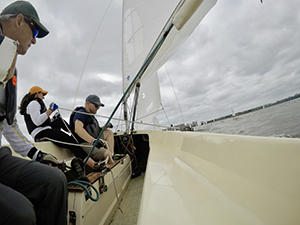A two-time School of Business alumnus (he received his undergraduate degree from the school in 1979, and his MBA in 1985), Pete Farrell came to sailing in a special way. “When my wife and I got married, we agreed that every five years we’d do something we'd never done before. Skiing was one of those things, whitewater rafting was another, and sailing was one,” he says. Thirty years ago, they bought a boat and a book on sailing and went out on the Potomac. Farrell remembers telling his wife, “Honey, you're going to have to read faster because we’re out here and my heart is in my throat.” Since then, they’ve become expert sailors. They’ve sailed 50-footers in the Caribbean and Pete is a regular sailboat racer.

Farrell’s sailing experience came from a marital promise, but his involvement in the Special Olympics began with his nephew, a Special Olympian golfer. Each year Farrell travels to Boston to watch his nephew compete. So, when a fellow sailor approached him 12 years ago about participating in the Special Olympics as a sailing coach, Farrell didn’t hesitate. “It's turned out great. I do it every summer—all the big regional races from the first of June through about the last weekend of July.”
Initially, he used a 14-foot boat with one athlete crew member. Boats that size, he explains, “usually get pretty wet.” Because some of the athletes have medical challenges that mean staying dryer is better, eventually Farrell was asked if he’d use his own, bigger and therefore dryer, boat. He agreed, and for the last six or seven years he’s had basically the same athletes as crew. His crew also includes a safety officer—usually a nurse. They practice every Monday and have dubbed their vessel “The Happy Boat.” “My usual crew, Rose and Jen, are just great.” Farrell says. “When they gave the awards out last year, they said, ‘Third place goes to the happy boat.’ Everybody knew who it was. Rose and Jen are relaxed but excellent sailors.”
Mostly in their 20s, the athletes generally don’t have sailing experience when they start. Farrell describes the evolution of the non-sailing Olympians into sailors as a “gentle process.” He notes that besides just teaching them the mechanics of sailing, “You have to teach them how a race course is set up and how races are run.” Racing courses depend on the wind at the time of the race. “They might set up two rounds to go around, but if it’s not a good breeze, it might be only once around. I divide my crew up so that one of them steers and tacks the boat upwind, and the other sails downwind.”
Farrell participates in a skippers meeting every Monday night before the Special Olympics practice. He says that most of the boats can go out in rough weather, but that the last thing the commodore says every Monday is, “Skippers, it is entirely up to you if you choose to take your athletes out on the water.” It’s good advice, Farrell says, “because it’s a reminder that it’s my responsibility to get everyone back safely.” He adds, “But you have to have a crew that knows exactly what's going to happen. And to have that kind of crew, you have to be sure of your directions.” Luckily, in the case of Farrell’s crew, he’s there to guide them and step in if something goes wrong. And, at this point, he’s good enough that nobody has to worry about reading faster.
